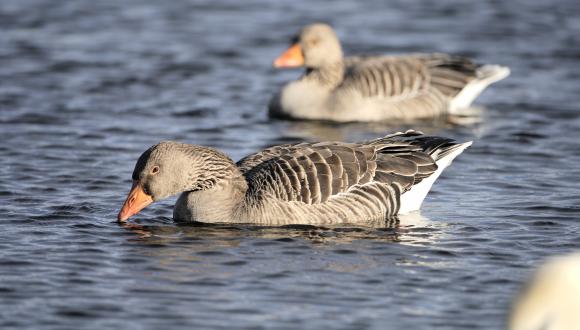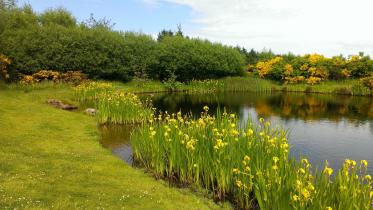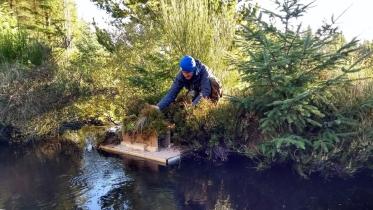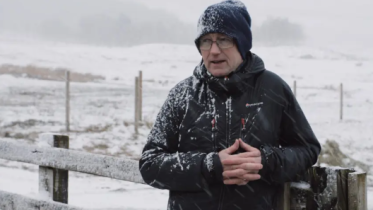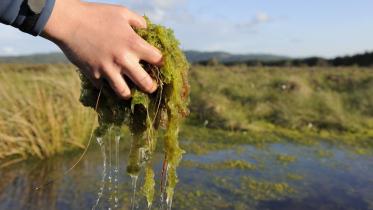Highly pathogenic avian influenza (bird flu) - Guidance for site managers
Updated: 2 June 2023
Guidance for site managers
The following sets out simple steps that site managers can take to limit the spread of highly pathogenic avian influenza (HPAI) by human activities and give vulnerable bird species the best possible chance of survival and recovery by reducing any additional stress. This guidance covers any site where significant numbers of wild birds gather to breed, feed or roost, such as islands, shorelines, wetlands, and inland waterbodies, and includes protected areas and non-designated sites. This guidance assumes that HPAI is continuing to circulate in wild bird populations and could arrive anywhere in Scotland during 2023 via infected birds or on contaminated clothing or equipment.
Background
The HPAI virus H5N1 is circulating widely within wild bird populations in Scotland. There is concern about the impact of HPAI on vulnerable bird species, particularly in waterfowl, seabirds and raptors.
Avian influenza is a virus that mainly affects birds and can result in mass mortality in some species. Migratory birds, especially water birds, can carry the virus along their migration routes and are thought to be responsible for bringing HPAI to the UK. In the current outbreak, however, the virus seems to have become established in a wider range of bird populations than in the past.
HPAI is spread by direct contact between birds through mingling, or indirect contact through feathers, faeces and other excretions. Influenza A viruses can remain infective for several months in freshwater at low temperatures and waterborne transmission may be a significant driver of infection in aquatic birds.
This guidance is based on reactive strategies for dealing with outbreaks of other diseases in wildlife and has the following aims.
- Reduce the spread of the H5N1 virus between sites by human activities. HPAI can be spread through direct contact, for example handling infected birds, or indirect contact through transfer of faeces and feathers. The H5N1 virus can survive on organic matter such as soil and nesting material for several weeks.
- Minimising the effect of other stressors on the birds. Common stressors include lack of availability of food, human disturbance, predators, and extreme weather events. Minimising human disturbance to sites at sensitive times of the birds’ life cycle is the quickest way to reduce unnecessary stress on the birds.
Actions for site managers
The following are general actions that site managers can take to limit the spread of HPAI by human activities and give birds the best possible chance of survival and recovery by reducing any additional stress.
As a precaution when there are no signs of avian influenza
- Warn visitors about the potential presence of HPAI and in particular not to pick up or handle dead birds..
- Provide local advice to visitors about how to minimise disturbance to feeding, resting or breeding birds.
- Encourage staff, volunteers and visitors to clean and disinfect their footwear before and after visiting seabird islands/colonies.
- Report sightings of sick and dead birds to the GB Dead, Wild Bird Surveillance Scheme online reporting system (see guidance on reporting sick and dead birds below).
When there is a suspension of activities in place (see below for the BTO/NatureScot HPAI Framework) take these additional actions:
- Limit access to areas where affected birds are feeding, resting or breeding.
- Stop all activities which require direct contact or handling of birds, unless NatureScot has approved a specific exemption. See below for advice on bird ringing and research.
- Our advice remains not to remove carcasses as this is unlikely to impact significantly on transmission rates. There may be a case for removing carcasses from sites where there is very high public access such as beaches. If it is suspected that a wild animal (including a bird) is infected with a disease that can spread to people or animals, such as avian influenza (which is a notifiable animal disease (NAD)), the carcases must be disposed of as a Category 1 ABP: Animal health and welfare: Animal by-products - gov.scot (www.gov.scot)
- Continue with planned conservation activities, such as monitoring, where this can be undertaken safely without walking through areas where affected birds are feeding, resting or breeding or causing additional stress to the birds.
- Seek advice from NatureScot if certain activities are however thought to be critical for conservation management.
The guidance below provides further details on these actions.
Visitor management
In Scotland, you can go on to most land to enjoy the outdoors – as long as you behave responsibly and follow the Scottish Outdoor Access Code. Scottish access rights apply, for example, to beaches and the coast, islands and lochs, regardless of whether they are protected areas, and include things like walking, climbing, kayaking, wild camping, and watching wildlife.
The Scottish Marine Wildlife Watching Code provides guidance to help visitors to enjoy these activities whilst minimising disturbance at sensitive times in birds’ life cycles. If people are not observing the Code, site managers or NatureScot can put up notices warning people that their presence on a site might have an adverse effect on wildlife.
This section of the guidance has the following aims
- Reduce the spread of the H5N1 virus between sites by avoiding walking through places where birds may be feeding, resting, or breeding.
- Reduce unnecessary stress on the birds by avoiding human disturbance to sites at sensitive times in the birds’ life cycle.
Site managers should warn visitors about the presence, or potential presence, of HPAI and in particular not to pick up or handle dead birds. Download this visitor information poster on HPAI to display at car parks and other access points.
Site managers should provide local advice to visitors, promoting routes which avoid walking through areas where birds are feeding, resting or breeding. This may include notices at boat landings, car parks, footpath diversions or closures, discouraging disturbance of breeding colonies or roosting sites, or wardens on site to liaise with visitors.
- More general access restrictions may be necessary where large numbers of birds congregate to feed, rest or breed. In such situations it is reasonable for site managers to request that visitors do not access such areas at sensitive times of the birds’ life cycle, especially during a severe disease outbreak.
General advice to give to visitors
The Scottish Marine Wildlife Watching Code provides the following general advice to help visitors to enjoy watching wildlife whilst minimising disturbance. Site managers should familiarise themselves with this guidance and encourage visitors to follow it.
- Avoid walking through places where birds may be feeding, resting, breeding or with their young.
- Be careful not to scare birds off nests or trample burrows/nests.
- Do not intentionally divide or put up flocks of birds.
- Follow any locally available advice about avoiding disturbance to wildlife. If you’re visiting a wildlife viewing site then you may be asked to follow specific routes to minimise disturbance.
- Use wildlife watching hides wherever possible
- Keep a good lookout and don’t get too close. Use binoculars or a telescope to get better views.
- Keep dogs under close control at all times as they can cause great disturbance. Keep dogs away from sick or dead birds.
Detailed advice for visitors and site managers
The Guide to Best Practice for Watching Marine Wildlife provides more detailed advice on how to avoid disturbance to birds in different situations.
- Birds nesting on the ground. Don’t get close to areas where you know birds nest. You may inadvertently trample on nests as both eggs and chicks can be extremely well camouflaged. Try to keep at least 200 metres from colonies of ground-nesting birds.
- Birds nesting in burrows. Look out for and keep your distance from burrows. If you walk over an area with burrows you may cause them to collapse, and you may deter birds from entering or leaving the burrows. Please follow any agreed information aimed at avoiding damage and disturbance. This may include keeping to specific routes to protect the burrows and a minimum approach distance as putting resting birds to flight causes additional stress and uses up precious energy.
- Birds nesting on cliffs. If you are watching from a boat, reduce speed to the minimum compatible with safety as you approach. We recommend a minimum approach distance of at least 50 metres, although this may be varied according to species and circumstance. If you go too close and cause panic departure, eggs or chicks may be dislodged from nesting sites.
- Birds at sea. Seabirds can form large groups, or rafts, on the sea both in summer and in winter. If you see a raft of birds ahead, reduce speed to less than 6 knots as you approach. We recommend a minimum approach distance of around 50 metres, although this may be varied according to species and circumstance. Avoid driving your boat, or other leisure craft, through rafts of birds – navigate around them where practicable and safe to do so. Breaking up rafts can make them more vulnerable to predators and uses up precious energy.
- Birds on the shore. On approach, try to establish what the birds are doing. If they are feeding, try to keep at least 50 metres away. If they are moving, try not to deflect them from their path – move in the same direction parallel to the birds. Try to keep at least 200 metres away from flocks of resting birds as putting them to flight causes additional stress and uses up precious energy.
The National Access Forum has produced guidance for site managers and access officers on managing access around sensitive wildlife. A sign template for breeding wildlife is available to download and print.
We have produced four signs that can be downloaded and printed for display on sites where avian flu is known / suspected:
- General advice for visitors
- Carcasses not being uplifted
- Please disinfect footwear
- No access beyond this point
Biosecurity measures for visiting seabirds islands
This section provides guidance for island managers, boat and cruise operators and tour guides on biosecurity measures to take before and after visiting island special protection areas for seabirds. Visitors should clean and disinfect their footwear before arriving on the island. Otherwise, place cleaning stations at main access points to the special protection area on inhabited islands.
Communicate with customers before they travel so that they know when to expect and to ask them to arrive with clean footwear, outdoor clothing, bags and equipment.
Information to provide to all visitors
Visiting our islands should be a memorable experience for everyone and inspire visitors about nature but we all have a responsibility to help protect it.
Whilst avian flu is spread by birds, human activity may also spread the virus between seabird colonies. Non-native species can also be spread by our activities and harm fragile island ecosystems.
Seeds, mircoorganisms and even invertebrates can hitchhike on footwear, clothing, bags or equipment that have been used outdoors previously.
By following a few simple steps, you can help prevent this.
Arrive Clean
Everyone visiting seabird colonies, especially on islands, can help prevent the spread of bird diseases and invasive species. Don’t give them an easy ride!
- Check your footwear, outdoor clothing and equipment before and after every landing or site visit. Pay special attention to boots, walking trousers, jackets, backpacks, walking poles, tripods, camera bags and equipment which have been in contact with the ground. Ask someone else to help you check places that are hard to see.
- Clean to remove soil, bird faeces, feathers, and dirt so that surfaces are visibly clean. Boot scrapers, scrubbing brushes and water will help. Boot soles trap dirt. A key or bent paperclip helps remove stubborn dirt, a scrubbing brush will remove the rest.
- Dip your footwear, walking poles and tripod in the footbath or government approved disinfectant mat provided or spray until the disinfectant runs off.
- Dry. Allow the disinfectant to dry on before you go onto the island. The disinfectant needs to be in contact with avian flu virus for at least 10 minutes to kill it effectively.
Leave Clean
Don’t forget to check, clean, dip and dry again when leaving the island, especially if you are travelling on to other locations that may have high concentrations of birds.
Creating a cleaning station
Create a cleaning station where visitors can remove any soil, bird faeces, feathers, and dirt before they travel to the island, and again before they leave.
- It should be readily accessible for all visitors
- It should have a hard surface, such as gravel or concrete, where washings can be contained and prevented from entering watercourses, drains or the sea.
- Provide a boot scraper or scrubbing brushes to remove any loose mud and dirt. Natural bristles, such as bahia or coir, are better for the environment than plastic.
- Provide water for removing stubborn mud and organic matter from footwear. Portable boot cleaners with a brush attachments are available.
Using disinfectants
Use a government approved disinfectant against bird flu, such as FAM30, Safe4 or Virkon S. Read the health and safety instructions and follow the dilution rates stated on the manufacturer’s label. Mix and prepare the disinfectant in the open air or in a well-ventilated area; you can do this on location or in advance. Wear appropriate PPE such as gloves and eye protection
Disinfectants are particularly toxic to aquatic ecosystems. To minimise any pollution, you should carry out the disinfection process on a flat area at least 10 metres away from any surface water drains or watercourses.
There are several different methods to apply disinfectants
- Footbaths. Cover these when not in use and replace the disinfectant regularly. Disinfectants can be deactivated more quickly by exposure to UV and dirt, or diluted by rainfall.
- Disinfectant mats are convenient for heavy use areas but are not always effective. Mats need to be protected from heavy rainfall and direct sunlight, topped-up with fresh disinfectant regularly and cleaned with water when they become dirty.
- Spray bottles are efficient for smaller numbers of visitors as you only mix as much disinfectant as you need. Spray surfaces with disinfectant until solution runs off.
Replace the disinfectant as recommended on the manufacturer’s label, which is usually when the colour of the solution fades. Small volumes (≤ 5 litres) of used disinfectant should be disposed of in a well-vegetated area, which must be at least 10 m away from any watercourse, ditch or surface water drain. In a built-up area, small amounts of disinfectant (≤ 5 litres) can be disposed of in a sewer, with prior approval from Scottish Water.
Bird ringing, research and monitoring
The British Trust for Ornithology (BTO) licenses bird ringing (fitting small metal identification rings to birds’ legs) under an organisational licence issued by NatureScot. In response to growing concern over the spread and impact of the current H5N1 strain of HPAI, the BTO has developed a ringing framework, to manage the risks to both birds and bird ringers, and has promoted this framework through the bird-ringing network. Any bird ringers operating on a nature reserve would be expected to be aware of and to follow the guidance in the framework.
The BTO framework also includes provision for the suspension of ringing for particular species or in particular areas when avian influenza is present. The BTO will communicate information about suspensions to ringers. NatureScot will inform partner organisations about suspensions at a national level and this will be communicated internally to site managers. NatureScot can agree exemptions from these suspensions for scientific work of especially high importance. NatureScot will discuss with organisations any exemption from suspension of ringing or research work proposed on the sites that they manage.
Bird monitoring
Additional biosecurity is necessary for bird monitoring which requires close inspection of nest sites or entering seabird colonies. Surveyors should thoroughly clean and disinfect clothing and equipment between breeding sites or when moving between different parts of seabird colonies. Following the protocol agreed with BTO and other country agencies monitoring may be suspended for particular species or in particular areas when avian influenza is present. NatureScot may also agree exemptions from these suspensions for scientific work of especially high importance.
Monitoring of bird populations and surveillance for numbers of dead birds may continue when avian influenza is present, provided this can be done without walking through areas where birds are feeding, resting or breeding or causing unnecessary stress on the birds. When HPAI is circulating widely within bird populations
- Surveyors should not enter breeding bird colonies where they have to walk between nests. Try to keep at least 200m from colonies of ground nesting birds and 50m from burrow nesting and cliff nesting birds.
- Wetland bird surveyors and goose counters should take extra care to avoid putting resting or feeding birds to flight.
- Vantage-point surveys can continue if they can be conducted without surveyors causing unnecessary disturbance to birds.
- urveyor should follow the Biosecurity Measures section above, including cleaning and disinfecting footwear and clothing, which may have become contaminated with mud, soil, faeces, etc., before entering or leaving the site.
Do not touch or pick up any dead or sick birds that you find.
Reporting of dead and sick birds
Do not touch or pick up any dead or sick birds that you find.
Please report dead wild birds to the GB Wild Dead Bird Surveillance Scheme online reporting service. Current criteria for reporting is detailed in the online publication - Avian influenza (bird flu): how to spot and report the disease.
This reporting system is run by the Animal and Plant Health Authority (APHA). The scheme monitors the spread of AI in wild bird populations in Great Britain to inform the disease HPAI risk assessment and to provide information on the general spread and nature of the virus. APHA will arrange for dead birds to be collected within 4 days, if they are needed for testing.
Not all birds will be collected. For example, they will not be collected if dead birds in the same area have been collected recently for testing, or if the dead birds are in locations which are difficult to access. In some cases APHA may ask NatureScot to help with sampling or collection of dead birds in remote locations and on islands. Only staff that have all necessary PPE, including a face fitted FFP3 facemask may take samples or collect carcasses, and only when asked to do so by NatureScot’s HPAI testing coordinator.
NatureScot has also invited reserve managers and volunteers in key locations to submit records of dead birds they see during the course their normal activities. Reserve staff and volunteers submit counts directly into an online database called Epicollect using a reporting app for mobile devices. NatureScot HPAI specialists review these records on a weekly basis to help track the progress of the outbreak.
If the dead birds meet the criteria for testing (above), recorders still need to report them to the scheme's online reporting service. The reporting reference number should be noted and added to the comments section of the Epicollect HPAI mortality database. This is important because it helps to tie-up the report with the test result when it is returned from the laboratory.
Disposal of carcasses
The general advice remains do not touch or remove carcasses. This is based on the following expert advice provided by virologists and animal health specialists at the Animal and Plant Health Agency (APHA) and Scottish Government.
- Carcass removal is unlikely to impact significantly on transmission rates
- While the risk to public health is very low there is still a risk which is why the message remains, “do not touch dead birds”
- Carcasses are treated as a Category 1 disease risk under the Animal By-Products (ABP) legislation and must be disposed of through an approved facility.
- There may be a case made for removing carcasses from sites where there is very high public access such as beaches.
- Any removal will require risk assessment and use of full PPE.
The benefits of carcass removal for limiting transmission are likely to be small unless a large majority of transmissions arise from carcasses, for example through scavengers assembling on carcases, and a large majority of all carcasses can be removed promptly. This is the conclusion of a risk assessment of wild bird carcass removal carried out by the Centre of Expertise on Animal Disease Outbreaks (EPIC). However, it may be that little harm, such as disturbance to breeding colonies and movements of infected birds, would be incurred through collecting carcasses. Where this is judged to be the case, further discussions with NatureScot about a more formally designed studies quantifying the potential benefits of carcass removal would be very valuable. Carcass removal will require careful consideration as to how carcasses will be disposed.
Where the landowner or operative deems it appropriate for a dead wild bird, suspected of being infected with HPAI, to be collected and disposed of, then the following guidance has been provided by SG Animal Disease Control Branch.
Operatives must still conduct their own dynamic risk assessments in line with their own employer’s policies and instructions and in line with other government department guidance. Operatives are also advised to engage with their local public health team representatives prior to collection of bird carcasses.
Please note: it is especially important that any operatives who own (or care for) their own (or other’s) poultry or other captive birds ensure they practice appropriate personal biosecurity if they have dealt with dead wild birds.
How should dead wild birds be disposed of?
If it is suspected that a wild animal (including birds) is infected with a disease that can spread to people or animals, such as HPAI (which is a notifiable animal disease, the carcasses must be disposed of as a Category 1 ABP as per the Animal Health and Welfare guidance.
Derogation exists within Scottish ABP legislation for certain areas of Scotland considered remote. The remote burial derogation exists in the Highlands and Islands, excluding the Isle of Bute, but should not be regarded as the first option, rather it should be the very last option considered for animal by product disposal purposes. Burial in such cases should be carried out in accordance with the Prevention of environmental pollution from agricultural activity (PEPFAA) code on disposal of animal carcasses.
Where dead birds are on public land, it is the Local Authorities’ responsibility to safely dispose of the carcasses as animal by-products (if disposal is required).
Advice on the collection of dead wild birds/carcasses
There is a possibility that you or your colleagues will be handling dead wild birds/carcasses infected with HPAI during this work. Therefore, exposure to HPAI may occur, although the risk of becoming infected yourself is very low. Transmission is by inhalation or ingestion of faeces and/or mucus secretions.
Reduce the risk of infection
Always wear protective clothing – disposable overalls, rubber/polyurethane boots (or disposable shoe covers), disposable face fitted FFP3 mask (or full-face respirator), safety goggles, disposable nitrile/vinyl/heavy duty rubber (not latex) gloves. PPE must be Face-fit Tested.
How to handle dead wild birds
Approach with caution and confirm the bird/animal is dead before attempting to handle it. When the dead wild bird has been picked up, a plastic bag can be turned back on itself and tied. It should then be placed in a second plastic bag, tied and disposed of as an animal by-product (as above).
Maintain a high level of personal hygiene
Gloves should be carefully removed and disposed of safely. Cover all cuts and abrasions with waterproof dressings before starting work. Always wash thoroughly with disinfectant soap and water after handling dead wild birds, or use anti-viral hand-wash/wipes. Wash any injuries – especially cuts – immediately, and cover with a waterproof dressing. Always wash your hands and exposed skin before eating, drinking, smoking or preparing food. Any clothing that has been in contact with the dead bird should be washed using ordinary washing detergent at the standard manufacturer’s recommended temperature.
Health restrictions
If you have any of the following, you should not collect carcasses until you have sought further advice from your H&S or Occupational Health representative:
- Are pregnant or breastfeeding
- Renal/kidney conditions
- Severe lung conditions (e.g. bronchitis; emphysema; cystic fibrosis)
- Immune system disorders
- Known severe allergic (anaphylactic) reactions to egg products, seasonal influenza vaccines, or anti-viral medications.
Other risks
Chemicals used for cleansing and disinfection can irritate your skin and lungs. Only use these chemicals according to the instructions and wear your protective equipment.
There may be manual handling risks involved with moving large, heavy birds, e.g. swans. Use good manual handling techniques. Do not attempt to lift any large carcasses if you have existing medical conditions that may be aggravated.
Take account of ground conditions, water hazards, weather etc. when assessing accessibility of carcass. DO NOT ENTER UNSAFE AREAS.
Government approved disinfectants
Please see the information from government about how and when to use disinfectant on the Government website.
Small volumes (≤ 5 litres) of used disinfectant should be disposed of in a well vegetated (grassed) area, which must be at least 10 m away from any watercourse, ditch, surface water drain etc. In a built-up area, small amounts of disinfectant (≤ 5 litres) can be disposed of in a sewer, but this can only be done with prior approval from Scottish Water.
Local authorities can seek further advice on disinfectant disposal from SEPA at: [email protected].
Contacts
HPAI and carcass disposal Alastair MacGugan Mobile: 07876 478305
Biosecurity and visitor management Stan Whitaker Mobile: 07786 126555
National Nature Reserve contact: Neil Mitchell Mobile: 07770 583927
